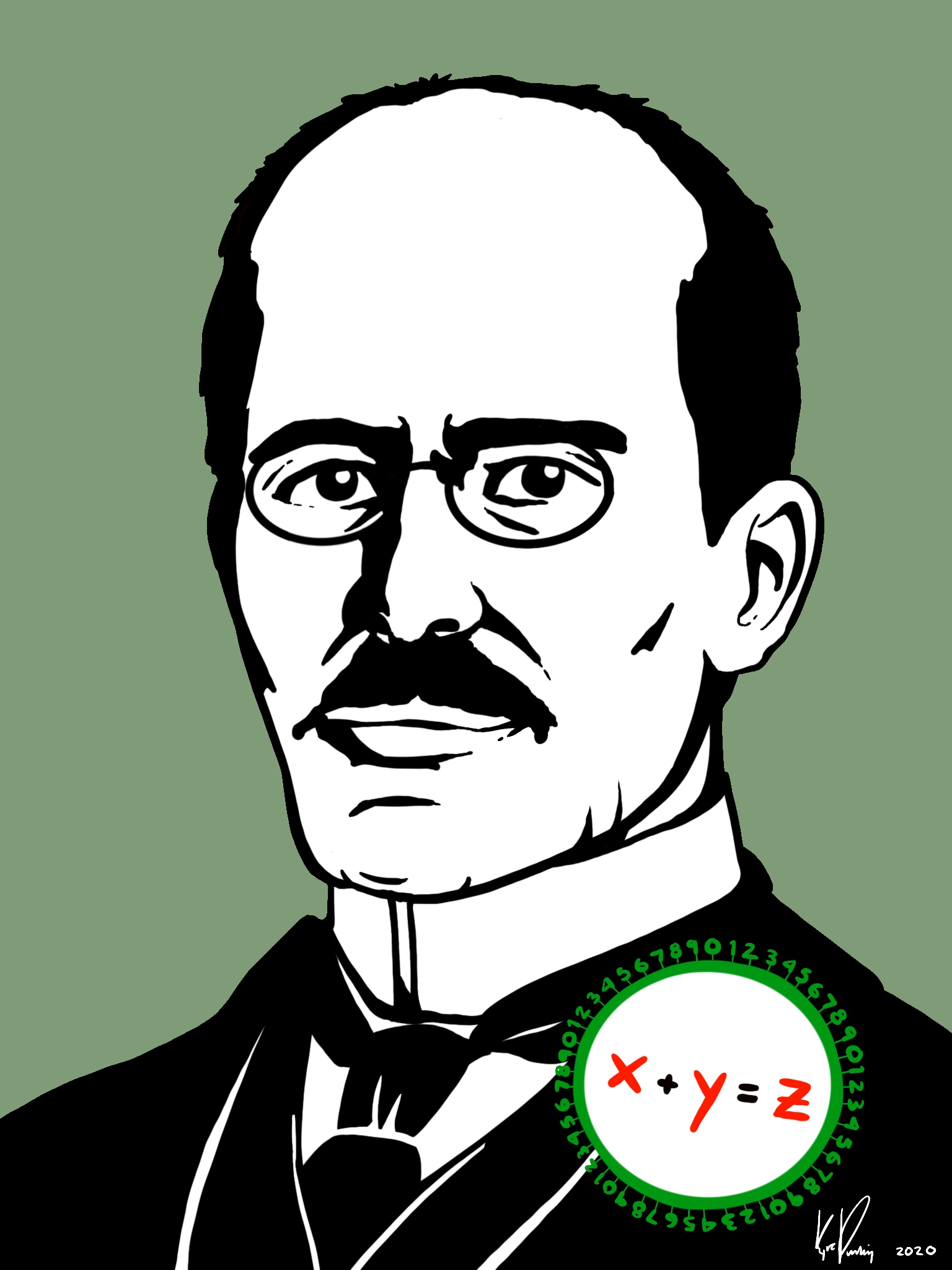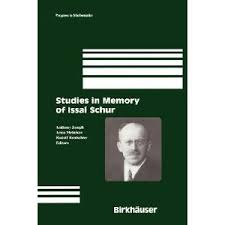Section 4.1 Issai Schur
To live without hope is to cease to live. — Fyodor Mikhailovich Dostoyevsky, Russian novelist, 1821 — 1881.
Who was Issai Schur? A mathematician who was born in the Russian Empire, worked in Germany for most of his life, and died in Palestine on his 66th birthday.
| Frobenius-Schur indicator | Herz-Schur multiplier | Jordan-Schur theorem |
| Lehmer-Schur algorithm | Schur algebras | Schur complement |
| Schur complement method | Schur decomposition | Schur function |
| Schur index | Schur indicator | Schur multiplier |
| Schur orthogonality relations | Schur polynomial | Schur product |
| Schur's inequality | Schur-convex function | Schur-Horn theorem |
| Schur-Weyl duality | Schur-Zassenhaus theorem | Schur test |
| Schur's lemma | Schur's lower bound | Schur's property |
| Schur's theorems in Ramsey theory, differential geometry, linear algebra, analysis | ||
Birth and Death. Issai Schur was born on January 10, 1875, in Mogilev, Russian Empire (now Belarus), and died at the age of 66 on January 10, 1941 in Tel Aviv, Palestine (now Israel).

World in 1875
World in 1941
Electric dental drill is patented
The first recorded hockey game (Montréal)
Georges Bizet's opera “Carmen” premieres
The Supreme Court of Canada is created
Alexander Graham Bell makes the first voice transmission
Tanaka Seisakusho (now Toshiba) company established
The first woman licensed to practise medicine in Canada
The Metre Convention Treaty signed
Louis Riel is granted amnesty

Issai's Family. Issai Schur was born in the family of a merchant Moses Schur and Golde Landau. In Berlin, on September 2, 1906, he married Regina Malka Frumkin, a medical doctor. They had two children, George, born in 1907, and Hilde, born in 1911.
Walter Ledermann about Issai Schur:
I attended many courses. But Schur's lectures were for me the most impressive and inspiring ones. It seemed to me that they were perfect both in content and in form. When I was in Berlin the elementary cycle consisted of Determinants (for a whole semester!), Algebra, Number Theory, Theory of Invariants. The more advanced cycle consisted of Galois Theory, Analytic Number Theory I and II, Ideals. Sometimes additional courses were offered by Schur; for example, the Theory of Matrices, Group Representations, Elliptic Functions. Schur was a superb lecturer. He spoke slowly and clearly and his writing on the blackboard was very legible. All his courses were carefully structured into chapters and sections, each bearing a number and an appropriate heading. His lectures were meticulously prepared. It is known that he had very full lecture notes, written on loose sheets which he carried in the breast pocket of his jacket. But I can remember only one occasion when he consulted his notes: during one of the lectures on invariants he wrote down a list of invariants of a certain quintic polynomial. He furtively pulled out a sheet of paper from his pocket in order to check whether he had remembered the rather complicated formulae correctly (he had!). He never got stuck in his lecture or failed to remember what he had said in the previous lecture. [4]
On 7 April 1933 the Nazis passed a law which ordered the retirement of civil servants who were not of Aryan descent. Schur was ‘retired’.
When Schur's lectures were cancelled there was an outcry among the students and professors, for Schur was respected and very well liked. [Schiffer]
Many years later, Menahem Max Schiffer recalled:
Schur told me [in Palestine] that the only person at the Mathematical Institute in Berlin who was kind to him was Grunsky, then a young lecturer. Long after the war, I talked to Grunsky about that remark and he literally started to cry: “You know what I did? I sent him a postcard to congratulate him on his sixtieth birthday. I admired him so much and was very respectful in that card. How lonely he must have been to remember such a small thing.” (Source MacTutor.)
Schur left Germany for Palestine in 1939, broken in mind and body.
“This volume is dedicated to the memory of Issai Schur. It opens with some biographical reminiscences of the famous school he established in Berlin, his brutal dismissal by the Nazi regime and his tragic end in Palestine. This is followed by an extensive review of the extraordinary impact of his lesser known analytic work. Finally, leading mathematicians in the representation theory of the symmetric groups, of semisimple and affine Lie algebras and of Chevalley groups have contributed original and outstanding articles. These concern many areas inspired by Schur's work as well as more recent developments involving crystal and canonical bases, Hecke algebras, and the geometric approach linking orbits to representations.”

Schur's Work - Three Examples.
Example 4.1.5.
Schur complement: In linear algebra and the theory of matrices, the Schur complement of a matrix block (i.e., a submatrix within a larger matrix) is defined as follows. Suppose \(A\text{,}\) \(B\text{,}\) \(C\text{,}\) \(D\) are respectively \(p\times p\text{,}\) \(p\times q\text{,}\) \(q\times p\) and \(q\times q\) matrices, and \(D\) is invertible. Let
so that M is a \((p+q)\times (p+q)\) matrix. Then the Schur complement of the block \(D\) of the matrix \(M\) is the \(p\times p\) matrix
It is named after Issai Schur who used it to prove Schur's lemma.

Applications: in solving linear equations, probability theory, and statistics.
Example 4.1.7.
Schur's inequality. For all \(x,y,z \geq 0\) and \(t > 0\text{,}\)
with equality if and only if \(x = y = z\) or two of them are equal and the other is zero. When \(t\) is an even positive integer, the inequality holds for all real numbers \(x, y\text{,}\) and \(z\text{.}\)
Proof.
Since the inequality is symmetric in \(x,y,z\) we take that \(x\ge y\ge z\ge0\text{.}\)
Use the fact that
to finish the proof.
Example 4.1.8.
Schur product. The Schur product (also known as the Hadamard product) of two matrices of the same dimensions, \(A=(a_{ij})\) and \(B=(b_{ij})\) is the matrix \(C=(c_{ij})\) such that
The Schur product \(\circ\) is commutative, associative and distributive over addition. That is,
Question: What is the identity matrix under the Schur product? Applications: The Schur product appears in algorithms such as JPEG. For more applications see Schur product - Wikipedia
Schur and Ramsey Theory.
Schur's Theorem: If the set of positive integers \(\mathbb{N}\) is finitely coloured then there exist \(x,y,z\) having the same colour such that
Schur and van der Waerden's Theorem: A. Soifer in his “The mathematical coloring book” (pages 331-332) proved that Schur conjectured the statement that we know as van der Waerden's theorem. Schur called it “a helpful lemma.”
Schur and Rado's Theorem: Schur's Ph.D. student Richard Rado in his doctoral thesis “Studien zur Kombinatorik” (1933) completely solved the following problem:
Let \(Ax = 0\) be a system of linear equations, where \(A\) is a matrix with integer entries. Under which conditions for every \(r\)-coloring of the set of positive integers \(\mathbb{N}\) the system has a monochromatic solution?
Resources.